Photo: Chronica Domus
Secreted away within Glimmerglass State Park's rolling woodland, and just at the edge of picturesque Otsego Lake, you'll find one of America's finest neoclassical country houses, and one which I had the distinct pleasure of visiting earlier this summer.
As you can see from the photograph above, although Hyde Hall could easily be mistaken for a nobleman's pile set deep within the English or Irish countryside, this splendid nineteenth century limestone house does indeed sit prettily in upstate New York, just eight miles from Cooperstown. To be perfectly fair, Hyde Hall does have a strong association with England as the man who built it, George Clarke (1768-1835), was indeed English. The architect, Philip Hooker, hailed from nearby Albany.
Built between 1817 - 1834 with inherited money from his namesake great grandfather, George Clarke turned Hyde Hall into the crown jewel of his sprawling 120,000 acre estate. Successive generations of the Clarke family, many of them also named George, lived happily in the house until the 1940's. In 1955, Thomas Hyde Clarke (b. 1936) inherited the estate but failed to keep it in the family when the state of New York claimed the house and 600 surrounding acres by eminent domain so as to create a state park. Shockingly, with no funds available for the house's upkeep, demolition loomed. If it were not for the tireless efforts of The Friends of Hyde Hall, a group which formed in 1964 to save the house and make it available for the enjoyment of the public, Hyde Hall would most certainly not have survived. What a travesty that would have been! Today, Hyde Hall is a National Historic Landmark and is open to visitors from the end of May through October.
Photo: Chronica Domus
Our mid-morning tour began at this charming 1820's structure known as the Tin Top Gatehouse. Originally located at the entrance of Glimmerglass State Park, the gatehouse was moved to its current location in 1974 and has benefited from recent restoration efforts to convert it to a visitor center. It was here that we met our guide, Gary, who delighted in showing us around the house and its grounds.
Say hello to Gary our erudite guide
Photo: Chronica Domus
What I really enjoyed most about poking around this enormous mansion, and what sets it apart from many other historic house museums I have visited, is that Hyde Hall is far from being "done up", by any stretch of the imagination, and that's just fine with me. As one who enjoys and appreciates the painstakingly involved processes of restoration and renovation, and all the minutiae revolving around such ventures, it was a rare treat to have an opportunity of viewing first-hand the numerous projects currently underway throughout the house.
Hyde Hall's entry door is flanked by four enormous columns
Photo: Chronica Domus
Let's start at the front door. Unfortunately, I missed photographing the tilted bollards either side of the entrance steps as I could not wait to cross the iron threshold. Obviously, my photo-journalistic skills are in great need of improvement. In my defense, my enthusiasm to see Hyde Hall did, I admit, get the better of me. Gary explained that the bollards prevented chipping and damage to the limestone from the procession of carriages that deposited the family and their guests at the front door. In turn, the bollards themselves are tilted inwards, thereby preventing damage to the carriages' wheel hubs.
Once inside, I was so distracted and absorbed by the many details of the entrance hall that I immediately fell behind our little tour group of five as I snapped away with my camera. As such, I failed to take detailed photographs of the drawing room. Oops!
The Scottish drum-head tall case clock makes a bold statement in the entrance hall
Photo: Chronica Domus
Another splendid detail of the entrance hall is this recently installed, over-sized, early-nineteenth century Argand lantern, restored to perfection and mounted on a pulley for ease of lighting
Photo: Chronica Domus
Although costly Brussels carpets or other floor coverings are nowhere in sight, one must obviously do one's best to remove mud from one's boots upon entering the house, done with the aid of a portable iron boot scrape and a rather charming long-handled bristle contraption
Photo: Chronica Domus
The only photograph I managed to take of the drawing room, as I raced to catch up with Gary and the group, was the image you see below showing one of a pair of fanciful gilded valances likely made by Lawton Annesley of Albany, New York, a dealer in mirrors and picture frames. The ceilings in this room are a neck-cracking nineteen feet high. One can only imagine how many yards of fabric were required to make the curtains for this room.
Acanthus and anthemion motifs give off a distinctly Greek vibe to this
beautifully carved and gilded valance
beautifully carved and gilded valance
Photo: Chronica Domus
On the other side of the entrance hall is the grand dining room. As you can see, the room is in the midst of an extensive renovation project so all the furniture, which is original to the house, was under wraps.
The two vapor-light chandeliers, purchased in 1833, dominate the dining room
Photo: Chronica Domus
A large part of the project focuses around the restoration of the walls, specifically the removal of the Victorian color scheme. In a historic house such as Hyde Hall this involves much more work than simply painting over an unwanted color.
Here's what the dining room looked like before the restoration project began
With the addition of sparkly mica and black pigment mixed into a lime wash, the room will again appear as it did in 1830. The resulting wall surface should match the marbleized original finish of the nearby drawing room and entrance hall walls.
Photo: Chronica Domus
A view of the dining room's window shutters draped with protective plastic sheeting
Photo: Chronica Domus
Photo: Chronica Domus
Hyde Hall is so large that I had a difficult time keeping track of the floor plan. From what I could determine the main house, known as the Great House, the section into which we entered, is just one of three which comprise the whole. The Great House was built between 1828 - 1833 and includes the entertaining rooms of Hyde Hall. The oldest part of the house, built in 1817, was once a free-standing south facing stone structure. That section of the house includes the family living quarters which spans ten rooms. The third part of the house is where the service quarters and second floor bedrooms are located. Over time, as Hyde Hall was extended, a central courtyard emerged. Here it is, seen in the photograph below:
The central courtyard can be glimpsed through the window of the smaller family dining room
which is in the original 1817 part of the house
which is in the original 1817 part of the house
Photo: Chronica Domus
A stylish solution to heating the family dining room
Photo: Chronica Domus
I was smitten with the dozen armchairs and side chairs found in the family dining room,
carved with a pretty leaf motif and made by John Meads, a leading local cabinetmaker, in 1819
Photo: Chronica Domus
As the name implies, the family dining room is where the family ate their everyday meals. The room is a far more intimate space than the grand dining room. Notice too that unlike the rooms of the Great House, with their marbleized walls which give off a rather chilly appearance, this room is painted in a warm apricot color. I like the family dining room because of the way it is furnished, and for the beautiful window which looks out onto the central courtyard. I also think the view into the room, which I captured below, is particularly appealing thanks in no small part to the handsome fanlight. One is instinctively drawn to the light-filled room after travelling along a dark and narrow corridor.
I loved the fanlight atop the door which leads into the small family dining room
Photo: Chronica Domus
I can't quite recall how I ended up behind the family dining room but once there, I was tempted to rest for a moment at this lovely little table where a game of backgammon was in progress:
The backgammon board appears to be fashioned in the form of a book
Photo: Chronica Domus
Truly lost within the maze of rooms at this stage of the tour, I believe the next room I stumbled into was George Clarke's office. Here it is complete with some "updates":
A view into George Clarke's office
Photo: Chronica Domus
Notice the heavy Tudoresque ceiling beams installed by a later descendant of George Clarke
and quite out of period to the rest of the architecture in the 1817 portion of the house
Photo: Chronica Domus
and quite out of period to the rest of the architecture in the 1817 portion of the house
Photo: Chronica Domus
Wandering past other rooms, including a chapel, formerly Mrs. Clarke's bed chamber and sitting room, we found this pretty and airy room.
A cozy spot for tea in front of the outer library's fireplace
Photo: Chronica Domus
One of a pair of restored Argand lamps that flank the outer library's mantelshelf
Photo: Chronica Domus
This room is part of a two-room library where twin banks of mahogany bookcases stand. These were commissioned by George Clarke from a local cabinetmaker.
This is one of two green baize-fronted mahogany bookcases which grace the inner and outer libraries, made by cabinetmaker Thaddeus Lacy, circa 1820 - 1821, in nearby Cooperstown
Photo: Chronica Domus
These rooms, whose walls are painted in a cheery apple-green tone, are flooded with natural light which might explain why the bookcases are fronted with green baize. As you can imagine, owning a sizable collection of leather-bound books must have cost a pretty penny in Mr. Clarke's day so their protection was paramount to both their enjoyment and longevity.
Again, the layout of this house has proved entirely perplexing to my recollections but onto the service wing we go.
This is one of my favorite views of the interior of Hyde Hall
Photo: Chronica Domus
To access the upstairs bed chambers, one must ascend this lovely tiger maple wooden staircase with its newly installed ingrain carpet.
Photo: Chronica Domus
The glorious detail of the tiger maple staircase was not lost on me
Photo: Chronica Domus
Once upstairs the jumble of rooms became a blur to my excited mind. All hope of photographically recording any of it was lost when our guide took our small group into the bed chamber, located above the Great House's portico. This is what I saw:
The supremely beautiful and tranquil view from the bed chamber
whose railing was made by Amos Fish of Albany, New York in 1833
whose railing was made by Amos Fish of Albany, New York in 1833
Photo: Chronica Domus
Surely, this was Arcadia. All I could think of doing was pulling up a chair and breathing in the stunning vista before me. Is it any wonder Mr. Clarke selected this remote spot, at the edge of Otsego Lake and the wooded hills beyond, to build his magnificent house?
My poor husband had to nudge me out of the room when it was time to resume the final portion of our tour, so transfixed was I by the view. Ah well, down the stairs we go.
Looking down the main staircase showing the elliptical half-curves of its design - interestingly, several of the balusters are grained and painted to resemble the handrail's mahogany wood
Photo: Chronica Domus
I'm not sure where this delightful curved door leads, positioned beneath the main
staircase, but I desperately wanted to peek inside
staircase, but I desperately wanted to peek inside
Photo: Chronica Domus
The service quarters of Hyde Hall were brimming with exciting developments. It is here that much work is underway to restore the kitchen and housekeeper's room to how it appeared in 1835.
Is there anything more thrilling to behold than the sight of equipment being readied
for an army of plasterers and carpenters to work their magic?
Photo: Chronica Domus
An adjoining room being readied for restoration
Photo: Chronica Domus
The room you see below, which held the family's china and porcelain - some of which would normally reside on the dining table of the great dining room but has been mothballed until that restoration project is complete - was lined with the most charmingly detailed shelving.
What a beautiful profile!
Photo: Chronica Domus
I spy pieces of old Paris Porcelain in among the pewter plates
Photo: Chronica Domus
Oh how I too could benefit from an entire room dedicated to the storage of
overflowing collections of dining accoutrements
Photo: Chronica Domus
Alas, finding our way back into the entrance hall heralded the conclusion of our visit. This had certainly been a fascinating amble through a house that is steadily reverting to the beacon of beauty she had so long ago been. I look forward to an encore visit once the dust has settled.
Photo: Chronica Domus
Do please consider stopping by Hyde Hall the next time you find yourself in the Cooperstown, New York area. The formidable efforts of those responsible for the ongoing restoration of this historic house should be commended. It really is rather special.
Hyde Hall
267 Glimmerglass State Park
Cooperstown
New York, 13326

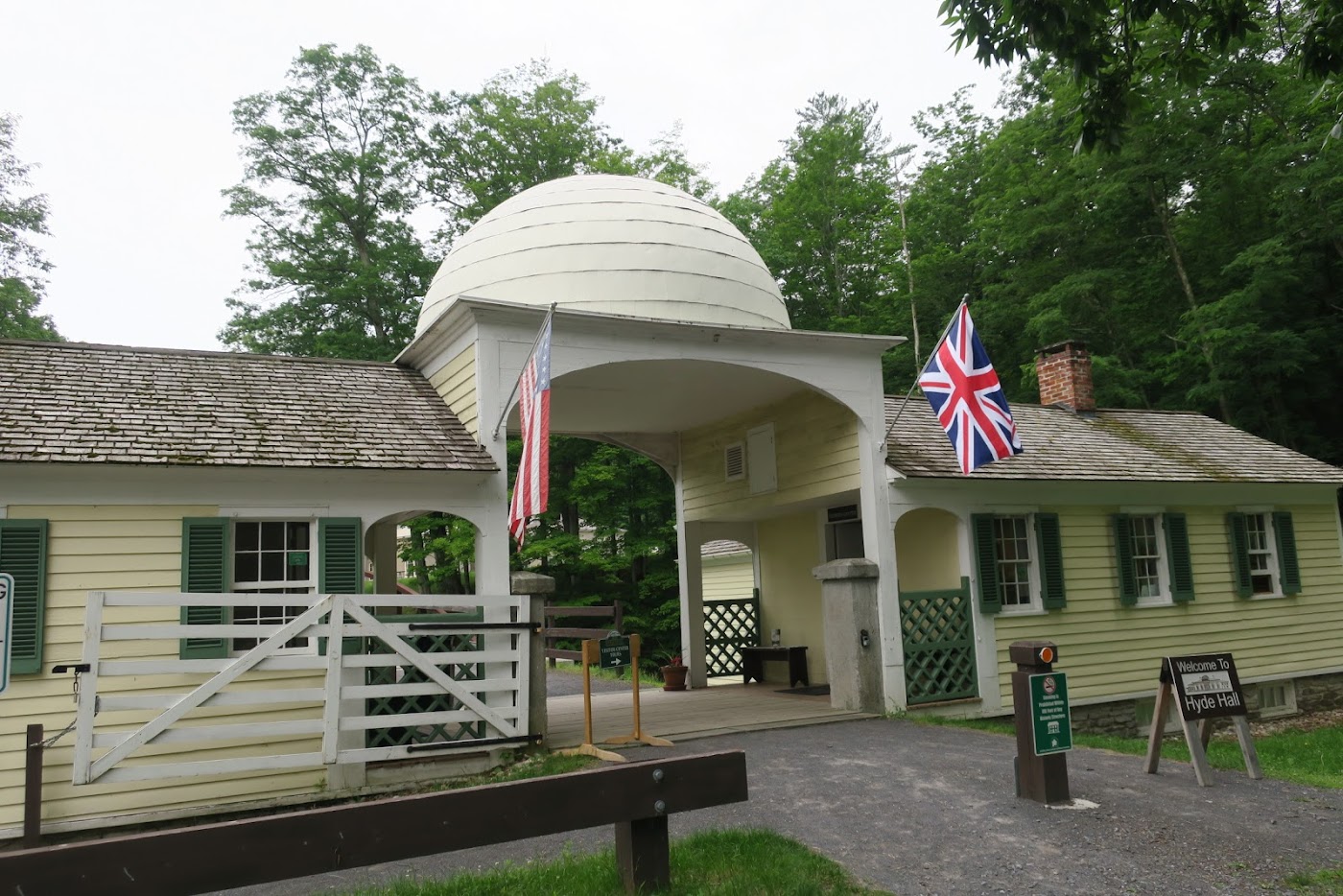



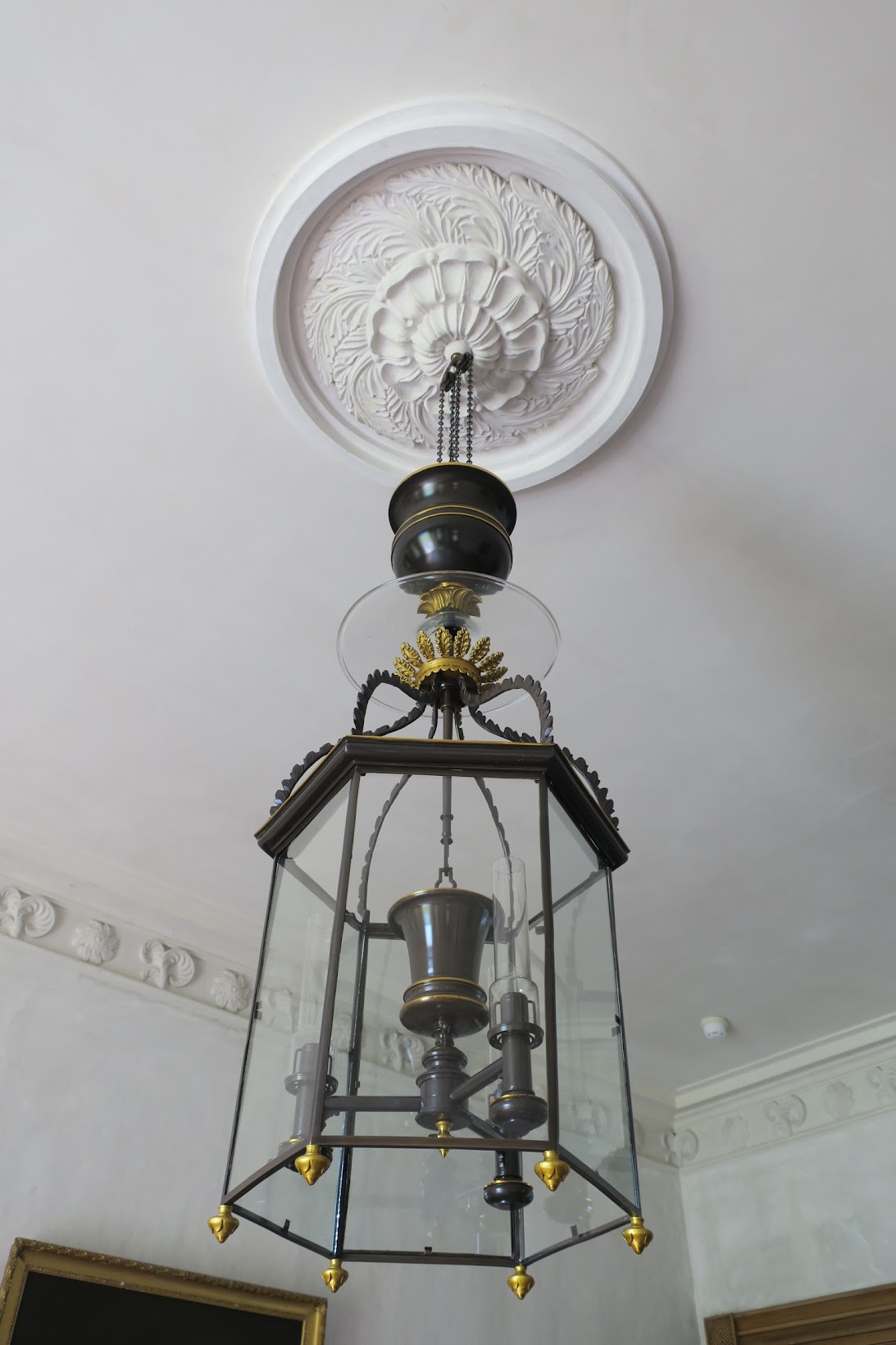
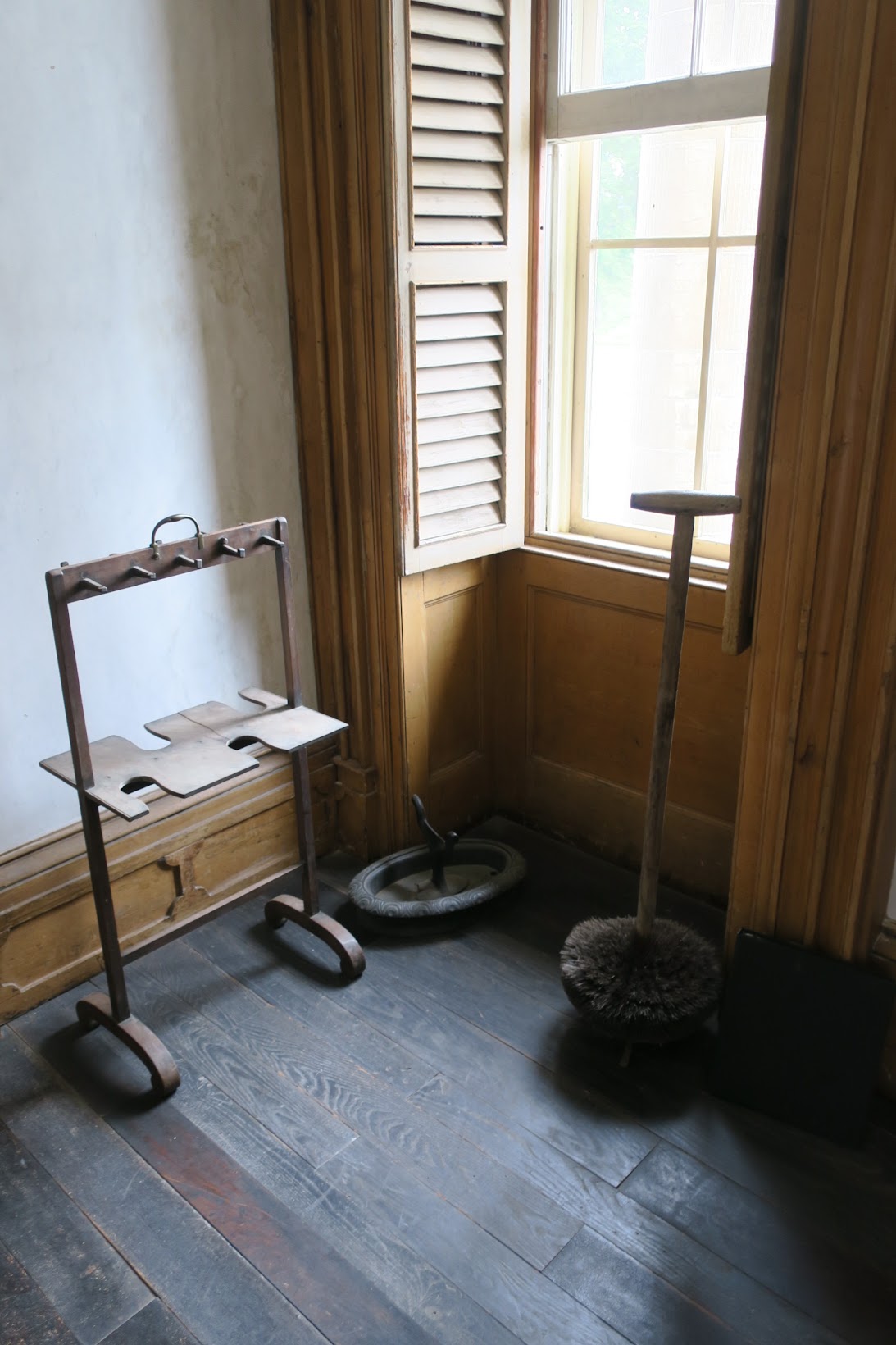



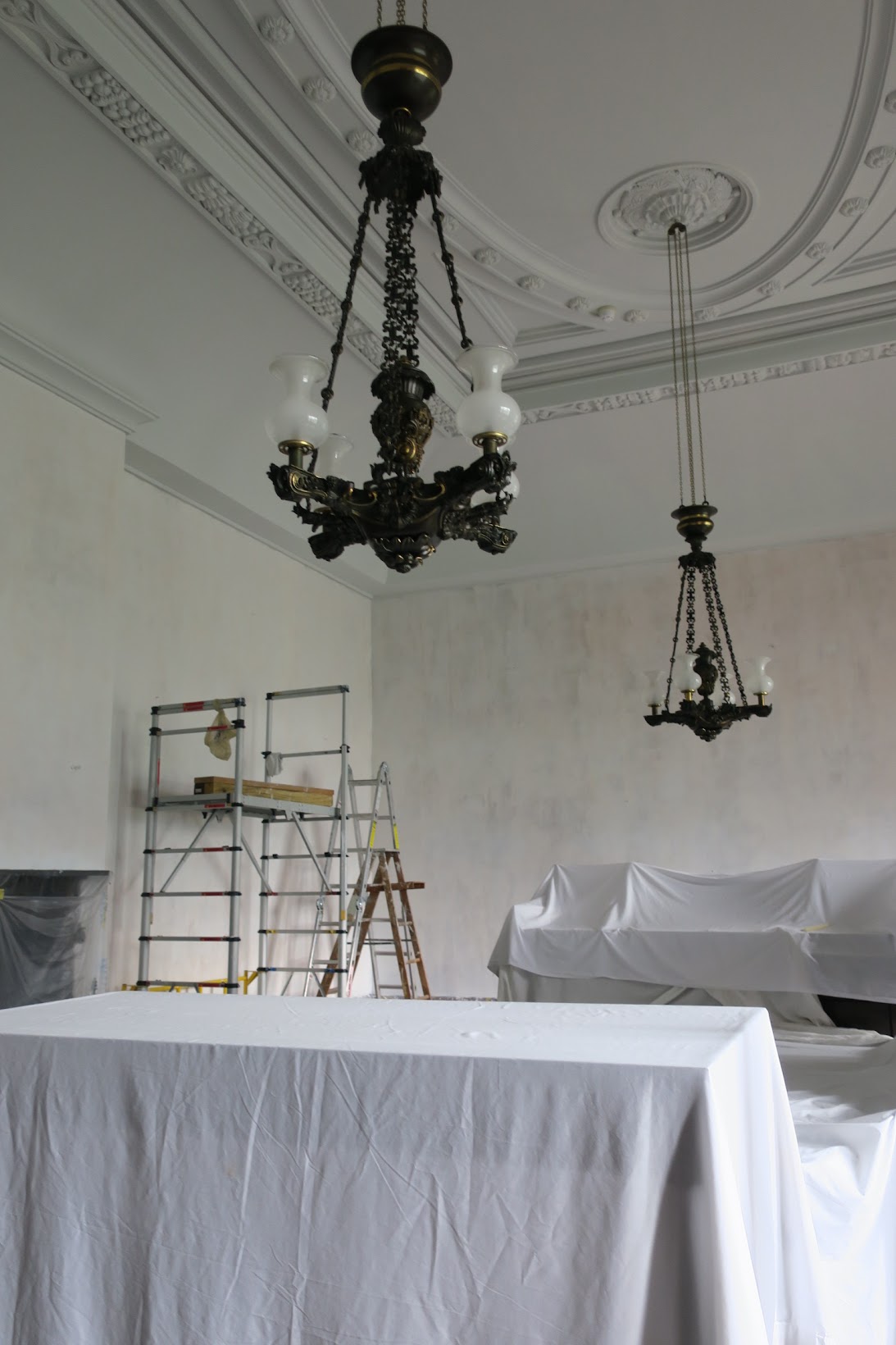








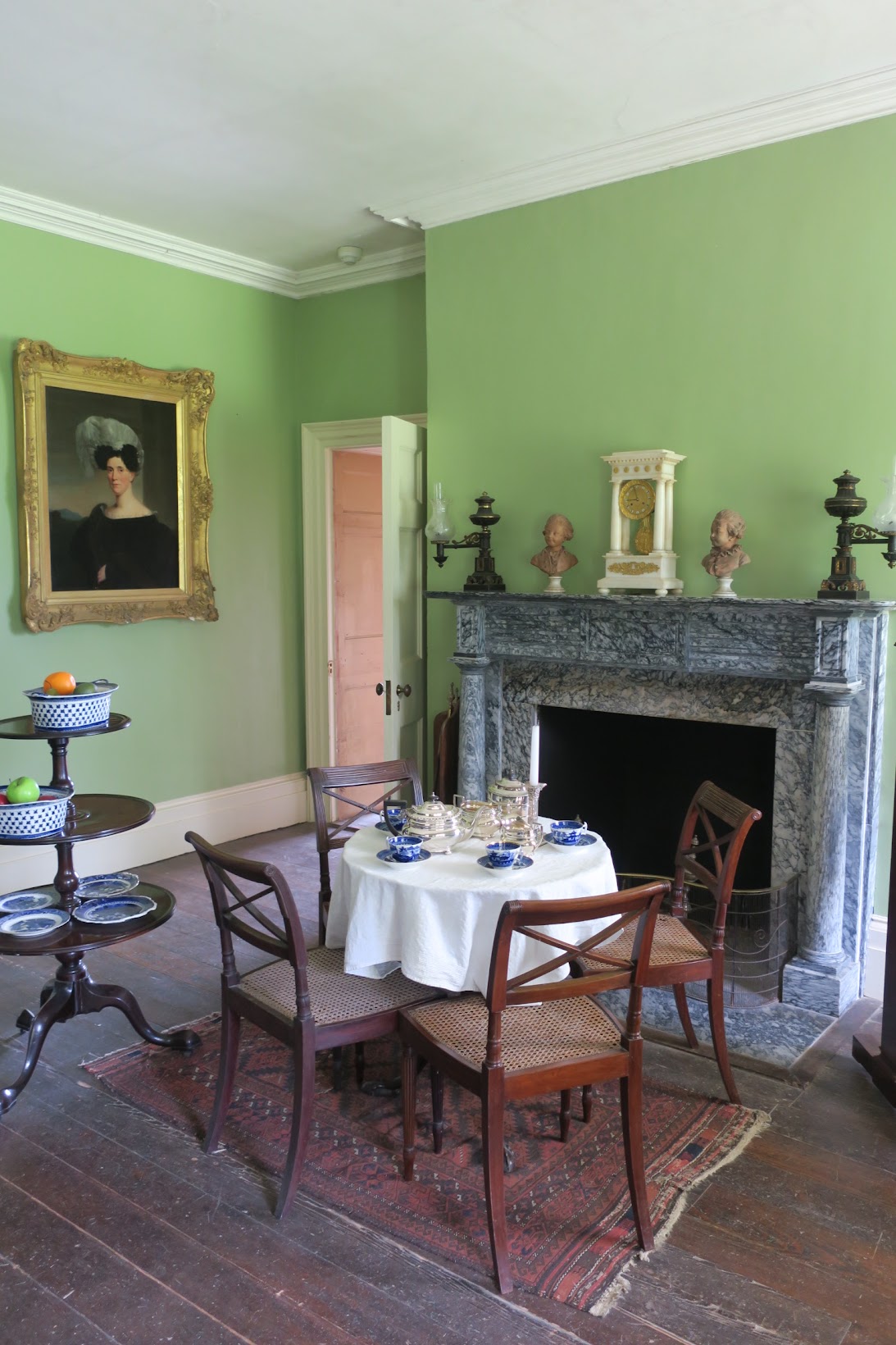





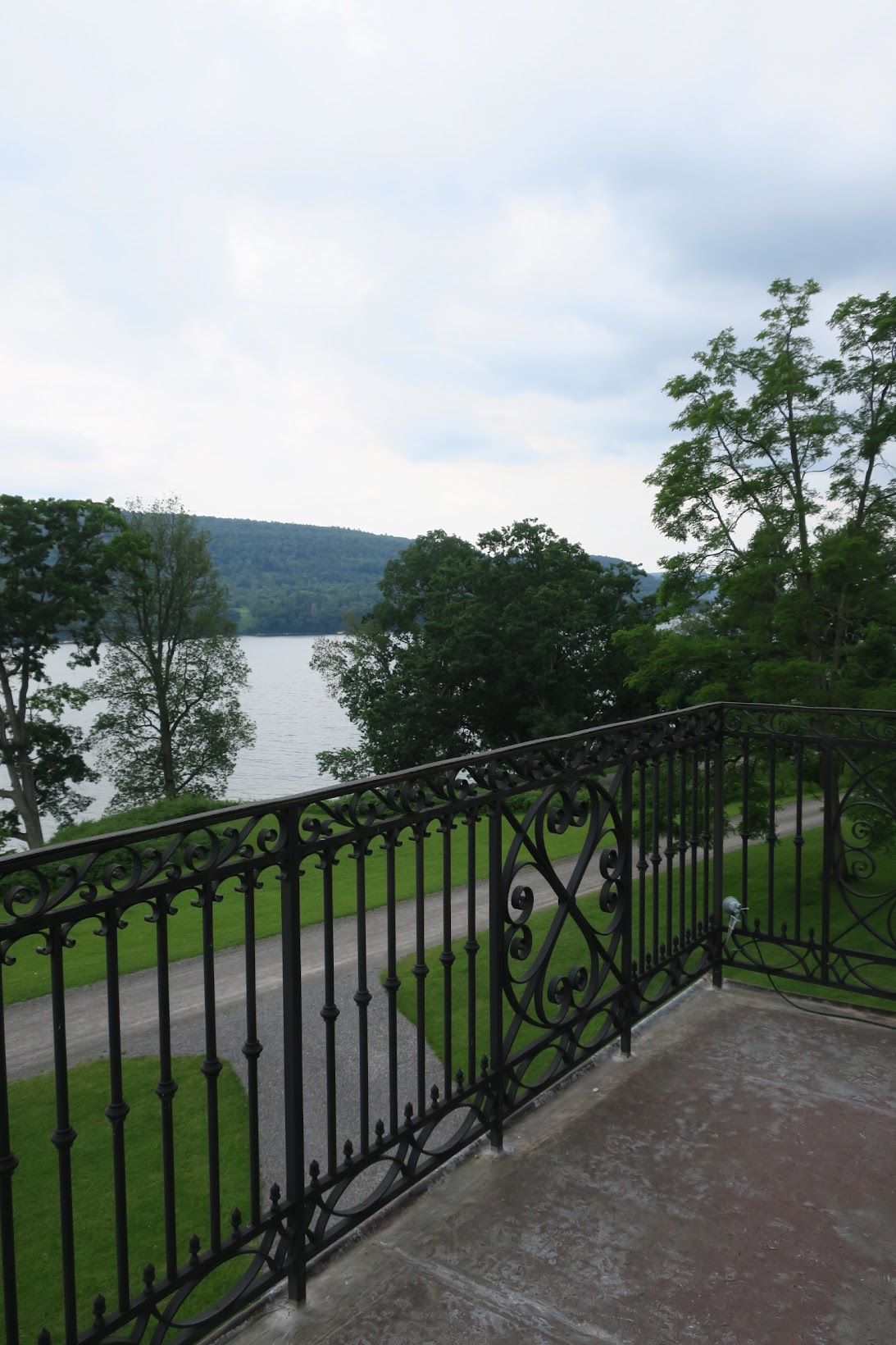








That's pretty. We try to go to upstate NY each summer. I've visited Sonnenberg in Canandaigua and now have a new spot to add to my list. Thank you!
ReplyDeleteHello Jen Lawrence,
DeleteWhen you do visit, make sure to also swing by the nearby Farmers' Museum in Cooperstown. It is a wonderful living history museum which recreates rural life in the early-nineteenth century. Many reconstructed buildings on the site, both farm related and not, and wonderful demonstrations of things like black-smithing, medicine making at the pharmacy, weaving, and broom making. Oh, and the Otisaga Hotel is also a must. If you can't stay, at least enjoy lunch or dinner on the terrace overlooking Lake Otsego.
Hello CD, I envy your visit to this fine house, especially since you got to see much work in progress as well as many fine furnishings and architectural details. I think my favorite was the curved door--I definitely would have opened it so see what was beyond; it did seem slightly ajar.
ReplyDelete--Jim
Hello Jim,
DeleteHyde Hall really was a fun place to poke around and I'd dearly love a return visit to see the progress of the projects that are taking place presently.
You are right, that curved door was ajar and I was sorely tempted to open it. Alas, my good manners prevented me from doing so. Perhaps if anyone from Hyde Hall is reading this blog post they might care to enlighten us as to what lies beyond the mystery door.
Hi! This is Gary, your guide. Thanks so much for such a thorough presentation of Hyde Hall! Behind that gorgeous steam-bent, faux painted door was the first flush toilet west of the Hudson River. George Clarke was a high tech gadget guy and in 1830 he had a water closet shipped from London, and installed in this alcove. The servants kept the tank filled through a very high cabinet door off the hallway. The best part: we still have it! At least the iron parts, anyway. We will be restoring and replacing it in the future, so keep in touch!
DeleteThank you, Gary, for filling in the missing piece to the puzzle on how that terrific door was fashioned (steam-bent!), and what hides behind it, or once did. Please do keep me posted, if you are able to, with the restoration of this fascinating and important little piece of HH.
DeleteCD
I am crazy for that curved door! How on earth??? And I am hoping it is a powder room! (I love them under the stairs!
ReplyDeleteThe carpender that constructed that door was indeed a talented fellow.
DeleteI've been in many houses where a powder room has been squeezed into the space beneath the stairs but I doubt that's the case at Hyde Hall.
Well, dear Penelope, it appears that you are indeed correct about the curved doorway and what lies beyond. Please see the final comments to this blog post. Very enlightening indeed!
DeleteThank you for this marvelous tour of Hyde Hall, one of America's great country houses of the early 19th century, and surprisingly little known to many. It certainly justifies greater appreciation. I first visited HH in the mid-1980s when much of the service wing was a near-ruin, and the rest of the house crumbling. I am most grateful for HH's rescue and ongoing restoration by its most-estimable Friends. A survivor when so much has been lost.
ReplyDeleteHello RD,
DeleteI can only imagine the state the house was in when you ventured there so long ago. Perhaps you'll consider visiting again, and soon, or at least once the kitchen wing is complete.
What a treat! That lake view is spectacular and I love the elegant wood/coal burning stove. Thank goodness Hyde Hall did not fall victim to the wrecking ball and is receiving the TLC is richly deserves.
ReplyDeleteBest,
KL Gaylin
Hello KL Gaylin,
DeleteAs I wrote above, I could have been perfectly content upon a chair, gazing at that heavenly view of the lake all afternoon. It was dreamy!
This comment has been removed by the author.
ReplyDeleteThank you Chronica for posting this! What a wonderful neoclassical building. I'd never heard of it. It does look like the country seat of an English family.
ReplyDeleteSo glad to have introduced Hyde Hall to you, Diogenes. Perhaps now you can make plans to visit the next time you find yourself out East.
DeleteDid you notice the flags flying from the Tin Top Gatehouse, a nod to both the British and American influences of the house?
I dont [know why though you might be able to articulate it better it is a beautiful house but it does feel very American even though it has classic elements to it. I should have gone when I lived in NY!
ReplyDeleteHello Naomi,
DeletePerhaps another trip to New York is on the works soon? Goodness knows there's plenty to keep you busy and a pilgrimage to Hyde Hall should be a must so put it on your list.
I wrote a comment before; but it disappeared into the ether. I wanted to recommend that you see the house museum to end all house museums in my book, Beauport in Gloucester, Mass. The first time I went, I bought 8 tickets because I couldn't keep up with the guide. (they eyed me rather suspiciously). Now, everytime we visit our daughter in Marblehead, I buy at least 4. Over and over, and I still can't see everything in that incredible place. I have visited 10 times. Fascinating! Do not miss if you haven't seen it!
ReplyDeleteAh, yes, Beauport. It is on my list for the next time I find myself in Massachusetts. We got close though, just down the road in Salem, but lacked the time required to tour this house and the insanely dense and varied collections held within.
DeleteMany thanks for sharing your visit to Hyde Hall. Seeing the details were of particular interest--for instance the Argand lantern in the entrance hall. Now that is something to covet!
ReplyDeleteIt may be of interest to know that Hyde Hall was featured in a book called "Historic New York: Architectural Journeys in the Empire State", written and conceived by Richard Reisem, with photographs by Andy Olenik. Published by The Landmark Society of Western New York.
Hello Toby,
DeleteI agree, the newly installed Argand lantern is a thing of beauty. It also happens to be perfectly scaled for the space in which it hangs. Can you imagine how it looks lit during the evening hours?
Thank you for sharing the title of the book which features Hyde Hall and other architectural gems around New York. I'd greatly enjoy taking a gander and will keep an eye out for it.
Hi - Gary again - we do love the new Argand lamp in the Entry Hall - and there are a number of smaller Argand lamps around the house - but our pride and joy are the two vapor lamps in the Dining Room, as noted in the body of the post. Hyde Hall is the only place in America, and perhaps the world, where you will see vapor lighting hanging in it's original position - and they work! We light them for special occasions, and it is a treat. On a similar note: we toured the Highland Light (or Cape Cod Light) in Truro, on Cape Cod, this week, and discovered that at one point (if I am remembering this correctly), the light was a large array of Argand lights inside a huge Fresnel lens.
DeleteHello Gary,
DeleteWhat a nice surprise to find your comment. Thank you for adding to the discussion on these outstanding lamps. In fact, I recall the entire house being filled with fabulous examples of early-nineteenth century lighting so I'm not at all surprised to learn about the vapor lamps being the only example still around.
I've always been fascinated by lighthouses and it must have been a real treat for you to visit the one in Truro, and to discover the Argand lights within it.
Thank you again for a wonderful tour of Hyde Hall. It was a highlight of a memorable trip out East and one that I hope to repeat in the future.
CD
The Curved door under the grand staircase one of two. The smaller one, not pictured was used to store firewood for the wood stove in the entrance hall which is fed from the rear.
ReplyDeleteThe larger door pictured was the door to the water closet. George Clarke (1768-1835) the builder of Hyde Hal installed the the first water closet west of the Hudson River. This was imported from James Bramah from England.
Hello John Bower,
DeleteI cannot thank you enough for clearing up that little mystery. I must have missed the second smaller curved door, but would enjoy a return visit just to peek into both doors.
The curved door under the stairs hides the water closet with what was once one of the first functioning toilets west of the Hudson River. Thank you so much for your glowing article. Hyde Hall is truly magic! Susan Monroe, Hyde Hall
ReplyDeleteHello Susan Monroe,
DeleteThank you so much for taking the time to comment, and for your effusive praise of my scribblings about my visit to Hyde Hall. I am amazed that the builder of Hyde Hall had the foresight to accommodate a functioning toilet beneath the stairs, a feature I did not thing was around back in the early 1800's. I shall be sure to take a peek the next time I find myself visiting this marvelous country estate.
Oh! I am delighted it was, in fact, a "powder room"! I was hoping! Ahead of its time!
ReplyDeleteDefinitely ahead of its time. Now, if only I could see it for myself (another trip is in order perhaps?).
DeleteFascinating! "steam bent"! I had an artist make two benches to fit in an oval entry hall.....I will ask him if that is how he did it!
ReplyDeleteYes, I bet that's how. Do report back on your findings. I wasn't even aware such curves were made with steam - brilliant!
Delete